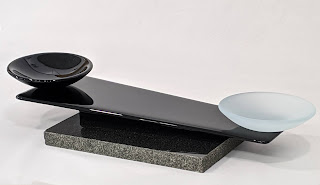Photo Transfer on Glass
 |
| Original image |
One of the techniques I was intrigued with was the author's method of transferring photographs to glass. I love being in nature with my camera, and of course, I love creating with glass. Here was a technique that allowed me to combine the two!
So months after reading the book and putting it away on the shelf, I finally decided to dust off the book and give the method a try. We had recently been backpacking in the Grand Tetons and I had some great photographs (well, OK, I'm biased, but I liked them!). The photo transfer technique relies on the image rendering well in black in white, which was a bit of a challenge, but I finally decided on a picture of wildflowers that was taken while hiking down North Cascade Canyon.
 |
| Photo transfer image on fused glass |
The fired image was 4x6". I decided its final destination would be on a white background tinted with colored frit, so I applied the frit to the white glass and fired. Once that was complete, I placed the fired photo transfer image on the glass (transfer-side up), capped with clear, and fired. The finished piece is to the right (sorry for the poor quality photograph, but I wanted to get a post written while the project was still on my mind). You'll notice that the black turned sepia colored -- that is one of the results of this technique (basically, the iron in the toner fires to a reddish brown).
There are manufacturers who make special photo paper for fusing, but this method has always seemed like "cheating" to me so I've never bothered. I suppose it's similar to the reasons I shy away from pre-made decals. Perhaps there is not much difference, but to me a technique feels more authentic and creative when it uses fewer prepackaged solutions. I like that I can use regular paper, a regular printer, glass, and a few other items I already have in my studio.
I enjoyed experimenting with the technique and plan to do a few more pieces to explore it further. What a great way to get all those images in nature onto glass!
Dana

